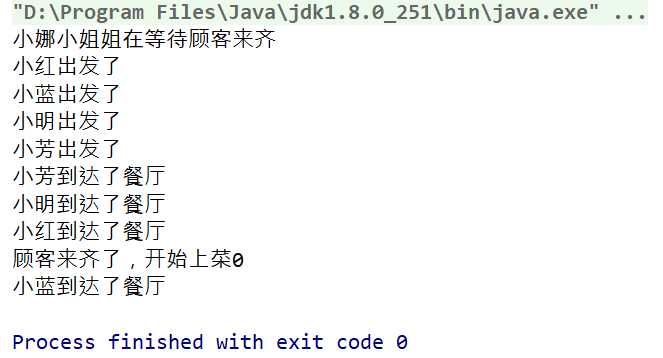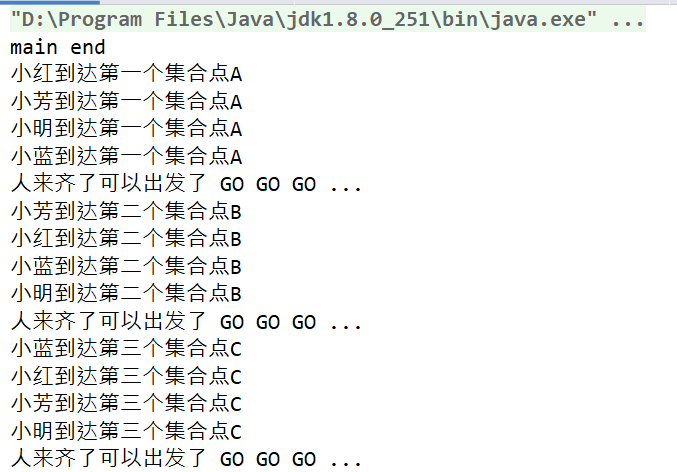CountDownLatch是JDK提供的一个同步工具,它可以让一个或多个线程等待,一直等到其他线程中执行完成一组操作。
现在小明、小红、小蓝、小芳约好一起到小娜的餐厅吃饭。然后大家都比较熟,所以就决定等到人来齐了的时候在上菜。但是大家也不是无限的等,等一定时间以后,实在等不到就先开始上菜。
public class Customer implements Runnable{
private CountDownLatch latch;
private String name;
public Customer(CountDownLatch latch, String name) {
this.latch = latch;
this.name = name;
}
@Override
public void run() {
try {
System.out.println(name + "出发了");
int time = new Random().nextInt(1000);
Thread.sleep(time);
System.out.println(name + "到达了餐厅");
latch.countDown();
} catch (InterruptedException e) {
e.printStackTrace();
}
}
}
public class Waitress implements Runnable {
private CountDownLatch latch;
private String name;
public Waitress(CountDownLatch latch, String name) {
this.latch = latch;
this.name = name;
}
@Override
public void run() {
try {
System.out.println(name + "小姐姐在等待顾客来齐");
latch.await(2, TimeUnit.SECONDS);//等一段时候后就不等了
System.out.println("顾客来齐了,开始上菜" + latch.getCount());
} catch (InterruptedException e) {
e.printStackTrace();
}
}
}
public class Main {
public static void main(String[] args) {
CountDownLatch latch = new CountDownLatch(3);
List<Thread> list = new ArrayList<>();
Customer customer1 = new Customer(latch,"小明");
Customer customer2 = new Customer(latch,"小红");
Customer customer3 = new Customer(latch,"小蓝");
Customer customer4 = new Customer(latch,"小芳");
list.add(new Thread(customer1));
list.add(new Thread(customer2));
list.add(new Thread(customer3));
list.add(new Thread(customer4));
Waitress waitress = new Waitress(latch,"小娜");
new Thread(waitress).start();
for (Thread t:list) {
t.start();
}
}
}
运行结果

CountDownLatch有一个内部类叫Sync,它继承了AbstractQueuedSynchronizer类,其中维护了一个整数state,并保证了修改state的可见性和原子性。
创建CountDownLatch实例时,也会创建一个Sync的实例,同时把计数器的值传给Sync实例,具体是这样的:
public CountDownLatch(int count) {
if (count < 0) throw new IllegalArgumentException("count < 0");
this.sync = new Sync(count);
}
private static final class Sync extends AbstractQueuedSynchronizer {//基于AQS实现的
private static final long serialVersionUID = 4982264981922014374L;
Sync(int count) {
setState(count);
}
int getCount() {
return getState();
}
protected int tryAcquireShared(int acquires) {
return (getState() == 0) ? 1 : -1;
}
protected boolean tryReleaseShared(int releases) {
for (;;) {
int c = getState();
if (c == 0)
return false;
int nextc = c-1;
if (compareAndSetState(c, nextc))
return nextc == 0;
}
}
}
在countDown方法中,只调用了Sync实例的ReleaseShared方法,具体是这样的:
public void countDown() {
sync.releaseShared(1);//计数器减1
}
其中releaseShared方法具体是这样的
public final boolean releaseShared(int arg) {
if (tryReleaseShared(arg)) {//state减一
//当state为0时唤醒阻塞的线程
doReleaseShared();
return true;
}
return false;
}
protected boolean tryReleaseShared(int releases) {
//以自旋的方式将state减1并返回锁是否完全释放
for (;;) {
int c = getState();
if (c == 0)
return false;
int nextc = c-1;
if (compareAndSetState(c, nextc))
return nextc == 0;
}
}
private void doReleaseShared() {
for (;;) {
Node h = head;
if (h != null && h != tail) {
int ws = h.waitStatus;
if (ws == Node.SIGNAL) {
if (!compareAndSetWaitStatus(h, Node.SIGNAL, 0))
continue; // loop to recheck cases
unparkSuccessor(h);
}
else if (ws == 0 &&
!compareAndSetWaitStatus(h, 0, Node.PROPAGATE))
continue; // loop on failed CAS
}
if (h == head) // loop if head changed
break;
}
}
public void await() throws InterruptedException {
sync.acquireSharedInterruptibly(1);
}
//实际调用的是这个
public final void acquireSharedInterruptibly(int arg)
throws InterruptedException {
if (Thread.interrupted())
throw new InterruptedException();
if (tryAcquireShared(arg) < 0)
doAcquireSharedInterruptibly(arg);
}
private void doAcquireSharedInterruptibly(int arg)
throws InterruptedException {
final Node node = addWaiter(Node.SHARED);//将当前线程分装为SHARED的Node
boolean failed = true;
try {
for (;;) {
final Node p = node.predecessor();
if (p == head) {
int r = tryAcquireShared(arg);
if (r >= 0) {
setHeadAndPropagate(node, r);
p.next = null; // help GC
failed = false;
return;
}
}
if (shouldParkAfterFailedAcquire(p, node) &&//将其上一个合法结点设置为SIGNAL状态
parkAndCheckInterrupt())//使当前线程park
throw new InterruptedException();
}
} finally {
if (failed)
cancelAcquire(node);
}
}
一种同步帮助,它允许一组线程全部互相等待以到达一个公共的障碍点。 CyclicBarriers在涉及固定大小的线程方的程序中很有用,该线程方有时必须互相等待。 该屏障称为循环屏障,因为它可以在释放等待线程之后重新使用。
现在小明、小红、小蓝、小芳约好一起去团建。具体流程如下:大家早上先到地点A处集合等大家都到了之后,再各自打车到团建目的地B入口等人齐了之后一起进去,结束之后大家约定一起从C出口等人齐了之后在各自回家。
public class Person implements Runnable{
private CyclicBarrier cyclicBarrier;
private String name;
public Person(CyclicBarrier cyclicBarrier, String name) {
this.cyclicBarrier = cyclicBarrier;
this.name = name;
}
@Override
public void run() {
Random random = new Random();
try {
Thread.sleep(random.nextInt(1000));
System.out.println(name + "到达第一个集合点A");
cyclicBarrier.await();
Thread.sleep(random.nextInt(1000));
System.out.println(name + "到达第二个集合点B");
cyclicBarrier.await();
Thread.sleep(random.nextInt(1000));
System.out.println(name + "到达第三个集合点C");
cyclicBarrier.await();
} catch (InterruptedException | BrokenBarrierException e) {
e.printStackTrace();
}
}
}
public class Main {
public static void main(String[] args) {
CyclicBarrier cyclicBarrier = new CyclicBarrier(4,()->{
System.out.println("人来齐了可以出发了 GO GO GO ...");
});
List<Thread> list = new ArrayList<>();
Person person1 = new Person(cyclicBarrier,"小明");
Person person2 = new Person(cyclicBarrier,"小红");
Person person3 = new Person(cyclicBarrier,"小蓝");
Person person4 = new Person(cyclicBarrier,"小芳");
list.add(new Thread(person1));
list.add(new Thread(person2));
list.add(new Thread(person3));
list.add(new Thread(person4));
for (Thread t:list) {
t.start();
}
System.out.println("main end");
}
}
运行结果

/** 同步操作锁 */
private final ReentrantLock lock = new ReentrantLock();
/** 线程拦截器 Condition维护了一个阻塞队列*/
private final Condition trip = lock.newCondition();
/** 每次拦截的线程数 */
private final int parties;
/* 换代前执行的任务 */
private final Runnable barrierCommand;
/** 表示栅栏的当前代 类似代表本局游戏*/
private Generation generation = new Generation();
/** 计数器 */
private int count;
/** 静态内部类Generation */
private static class Generation {
boolean broken = false;
}
/**
创建一个新的CyclicBarrier,它将在给定数量的参与方(线程)等待时触发,并在触发屏障时执行给定的屏障操作,由最后一个进入屏障的线程执行 */
public CyclicBarrier(int parties, Runnable barrierAction) {
if (parties <= 0) throw new IllegalArgumentException();
this.parties = parties;
this.count = parties;
this.barrierCommand = barrierAction;
}
/** 创建一个新的CyclicBarrier,当给定数量的参与方(线程)在等待它时,它将跳闸,并且在屏障跳闸时不执行预定义的操作 */
public CyclicBarrier(int parties) {
this(parties, null);
}
public int await() throws InterruptedException, BrokenBarrierException {
try {
return dowait(false, 0L);
} catch (TimeoutException toe) {
throw new Error(toe); // cannot happen
}
}
//定时等待
public int await(long timeout, TimeUnit unit)throws InterruptedException,
BrokenBarrierException,
TimeoutException {
return dowait(true, unit.toNanos(timeout));
}
这个两个方法实质上都是走的dowait方法,只不过传递的参数不同
private int dowait(boolean timed, long nanos)
throws InterruptedException, BrokenBarrierException,
TimeoutException {
final ReentrantLock lock = this.lock;
lock.lock();//加锁操作
try {
final Generation g = generation;
//检查当前栅栏是否被打翻
if (g.broken)
throw new BrokenBarrierException();
//检查当前线程是否被中断
if (Thread.interrupted()) {
breakBarrier();
throw new InterruptedException();
}
//每次都将计数器的值-1
int index = --count;
//计数器的值减为0,则需要唤醒所有线程并转换到下一代
if (index == 0) { // tripped
boolean ranAction = false;
try {
//唤醒所有线程前先执行指定的任务
final Runnable command = barrierCommand;
if (command != null)
command.run();
ranAction = true;
//唤醒所有线程并转换到下一代
nextGeneration();
return 0;
} finally {
//确保在任务未成功执行时能将所有线程唤醒
if (!ranAction)
breakBarrier();
}
}
//如果计数器不为0 则执行此循环
// loop until tripped, broken, interrupted, or timed out
for (;;) {
try {
//根据传入的参数来觉得是定时等待还是非定时等待
if (!timed)
//如果没有时间限制,则直接等待,直到被唤醒
trip.await();
else if (nanos > 0L)
//如果有时间限制,则等待指定时间
nanos = trip.awaitNanos(nanos);
} catch (InterruptedException ie) {
//若当前线程在等待期间被中断则打翻栅栏唤醒其它线程
if (g == generation && ! g.broken) {
breakBarrier();
throw ie;
} else {
// 若在捕获中断异常前已经完成在栅栏上的等待,则直接调用中断操作
Thread.currentThread().interrupt();
}
}
//如果线程因为打翻栅栏操作而被唤醒则抛出异常
if (g.broken)
throw new BrokenBarrierException();
//如果线程因为换代操作而被唤醒则返回计数器的值
if (g != generation)
return index;
//如果线程因为时间到了而被唤醒则打翻栅栏并抛出异常
if (timed && nanos <= 0L) {
breakBarrier();
throw new TimeoutException();
}
}
} finally {
lock.unlock();//最终解锁
}
}
//当计数器的值减为0,则需要唤醒所有线程并转换到下一代
private void nextGeneration() {
// signal completion of last generation
trip.signalAll();
// set up next generation
count = parties;
generation = new Generation();
}
//若当前线程在等待期间被中断则打翻栅栏唤醒其它线程
private void breakBarrier() {
generation.broken = true;
count = parties;
trip.signalAll();
}
相同点:
不同点:
参考链接:https://mp.weixin.qq.com/s/jfCLg7OjTsZ5sIJhGXAM2A
原文:https://www.cnblogs.com/uanghaou/p/14773674.html